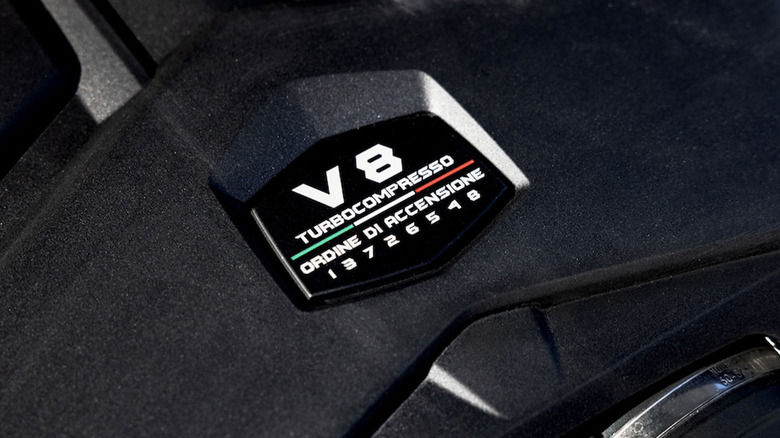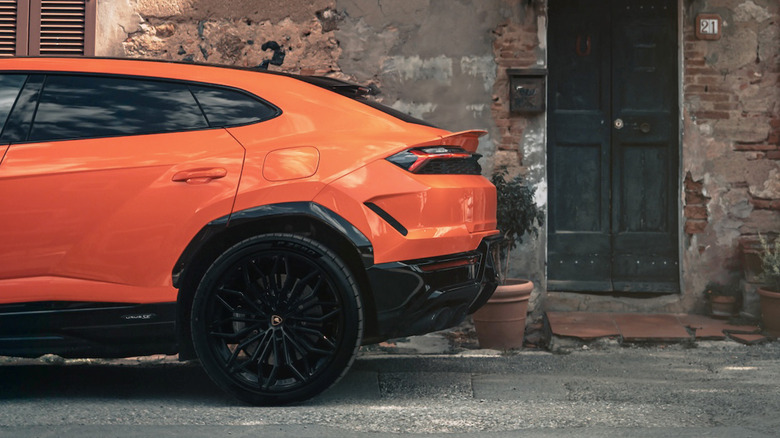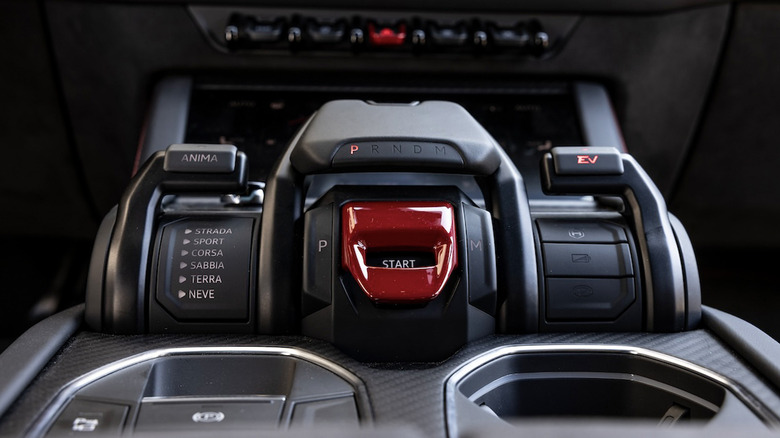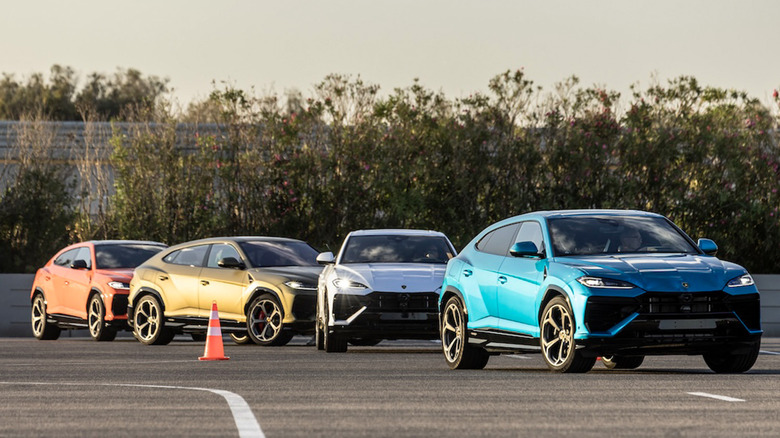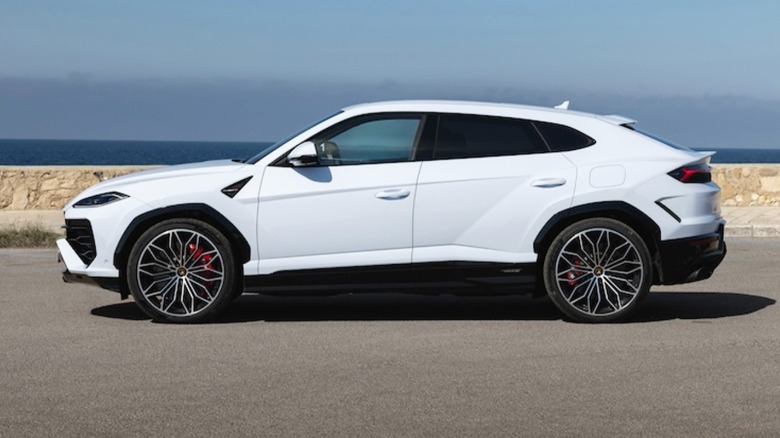After Ferrari debuted its new F80 and McLaren unveiled the W1, seemingly the entire automotive enthusiast community came together to bemoan the future of bland and boring electric vehicles approximately as exciting as kitchen appliances. Hold your horses, neigh-sayers! The effectiveness of performance hybrids remains irrefutable, especially at the upper echelons of the market. Case in point? The F80’s predecessor, the LaFerrari, as well as McLaren’s P1. And whether or not Porsche follows up the 918 Spyder with a hybrid or a fully electric hypercar, all the tech and performance on these icons still continues to trickle down to consumer cars, too.
Advertisement
Lamborghini entered the hybrid game a bit later than the competition, initially with the supercapacitor-powered Sian. But fast forward just four years, and Lambo already sits at the forefront of legacy supercar manufacturers in tech terms. That’s thanks to the screaming Revuelto and Temerario supercars, plus of course the new Urus SE, a plug-in hybrid version of Sant’Agata Bolognese’s bread and butter that will undoubtedly outsell all of the above.
Sure enough and soon enough, Urus SE SUVs will start to appear on the high-falutin streets of West LA, so to prepare my mind, body, and soul for the inevitable, I recently traveled to the countryside around Bologna to assess whether this latest of Lambo’s greatest truly manages to up the performance potential, or simply adds a few miles of silent, convenient operation in the name of reducing greenhouse gas emissions.
Advertisement
The most powerful SUV on the market
For a bit of context before jumping into the meat of the matter, the Urus SE adds a 25.9-kilowatt-hour lithium-ion battery below the rear trunk while the twin-turbo 4.0-liter V8 carries over from the previous Uruses (Urii?), albeit in this case tuned to slightly reduced output of 612 horsepower and 590 lb-ft of torque. The internal-combustion engine can take a literal load off because an electric motor inside the SE’s eight-speed torque converter automatic delivers an instantaneously available 189 horsepower and 356 lb-ft of torque. That bumps the total combined ratings up to 789 ponies and 701 lb-ft, with the latter available at just 1,750 RPM.
Advertisement
Adding the plug-in hybrid system results in the Urus reclaiming the title of most powerful SUV on the market, which falls in line with Lambo’s longstanding insistence that electrification will improve performance rather than simply cutting down on emissions to please the greenie-weenies. (And really, sales volumes at this price point—$262,000 plus delivery and destination, for those following along, as well as whatever options come to the wildest flights of fancy—means the environmental impact will always be limited by sheer economics.)
Somehow sprinting slower, though
And yet, the Urus SE can “only” manage a meager 3.4-second sprint to 100 kilometers an hour (62 mph) according to Lamborghini’s press release. That’s just a tenth of a tick quicker than the Urus S, and slower than the Urus Performante—plus, the first paragraph of that aforementioned press release boasts of an 80% drop in emissions.
Advertisement
Yet, I flew into Bologna harboring little doubt about the SE’s performance potential. First of all, Lambo Chief Technical Officer Rouven Mohr owns a Lancer Evo and second, the Revuelto already proved time and time again how the advantages of a plug-in hybrid outweigh the physical weight—at least, in terms of pure joy.
Lamborghini’s hybrid systems focus on performance, not emissions
While tracking a Revuelto at Vallelunga last year, and then spending a week hammering one here in the United States this past summer, the hybrid supercar’s gobsmacking power combines with an almost unbelievable level of grip thanks to the discrete traction control programming made possible by tri-motor torque vectoring. Chortling in childish glee, I hit speeds entirely inappropriate for either a small circuit or public roads, and held cornering g forces equally as outrageous. The only hint that the Revuelto weighs around 4,000 pounds appeared after the fact, in the form of tire wear.
Advertisement
C’est la supercar vie, though, since anyone shelling out for a Lambo these days indubitably cares less than a lick about the price of Michelin Pilot Sports (that they might want to buy by the baker’s dozen). Plus, the supercar life becomes easier with a Revuelto thanks to the ability to switch into fully electric, nigh-silent Citta mode for a few miles, reducing the incessant thrum of a V12-shaped neighborhood alarm clock.
Swaddled into a comfortable super SUV
Living with a newly refined, ridiculously lowslung two-seater pales in comparison to the luxury of living with an Urus, however. In Italy, I consistently kept the ventilated seats blasting and massage function kneading, with the tunes cranked up just loud enough to reveal hidden highs and deep bass notes that so many automotive sound systems muffle—but without muffling the barking V8’s exhaust burble, either.
Advertisement
Other than when I flipped into the Urus SE’s Citta mode, anyhow, which offers an order of magnitude more range at over 60 kilometers (around 37 miles). Thank the Volkswagen Group family roots for Rimac battery tech, perhaps, but the Porsche, Audi, and VW-ness of the Urus still shines through in spades. Sufficiently convinced of the Urus SE’s performance before even setting foot in one, I still wondered in advance how, exactly, Lambo decided to differentiate this plug-in hybrid SUV from the conglomerate’s siblings.
More power more better more massive
Obviously, more power helps. But in the past, the Urus weighed a few hundred pounds less than the top-spec Cayenne thanks to the abundant use of carbon fiber. On the roads of northern Italy, though, the SE greeted me with 5,520 pounds of curb weight—or about 15 percent more than a Performante, but still 500 more than a non-hybrid Cayenne Turbo GT. From the first nudge into throttle, instantaneously-available torque clearly compensates for that additional heft, especially because the electric motors effectively reduce the gearbox’s tendency to downshift once or twice before blattering out the twin-turbo V8’s bombastic grunt.
Advertisement
Equally quickly, though, I noticed the additional weight. Over undulating roads, more than cracks or speed bumps, the SE in Strada mode rafts a bit as the chassis and suspension put in concerted effort to hide the increased mass. Maybe I remember the Urus Performante, which swapped in steel springs instead of air bags, better with a bit of recency bias. But I certainly recall the base Urus squatting under hard acceleration, bucking upward and forward before launching forward through time and space.
Keeping the SE under control
The SE, on the other hand, stays more planted regardless of driving style. I suspect Mohr attempted to quell such a rollicking personality, in this case, by keeping the airbags pumped up a bit firmer. Similarly, the 48-volt adaptive anti-roll bars also noticeably actuated more frequently while cornering, occasionally with enough input to render my steering line a bit off-kilter. Maybe Lambo even dialed back the steering effort—or increased the power assist, however you want to look at it—to further emphasize a lighter spirit for the SE.
Advertisement
Of course, all of the above in Strada mode then changed when I smacked through the fighter jet-inspired controls and found Sport, then Corsa. Here, the firmer steering and stiffer damping actually improved the ride, as the road provided additional steadying force. But the Catch-22 came in the form of additional feedback from smaller road imperfections reverberating into the cockpit, which the Urus SE in Strada mode eliminates in the hopes of providing that more luxurious and daily drivable ride quality.
Slight aesthetic revisions for the SE
The more aggressive drive modes also open up further exhaust valving to release every last pent up snarl from the V8, while ramping up throttle response and raising the transmission’s shift points higher into the ICE power band. And the real truth? Most buyers will likely fail to notice the SE’s dad bod amid the nonstop revelry.
Advertisement
The main clue to the powertrain changes beneath the skin comes in the form of that skin itself, newly squared-off with boxier aero edges and a rear light bar that trends a bit nearer to Porsche design language. On the interior, a new set of drive mode switchgear for controlling the hybrid-electric system also serves as a reminder that the driver can tell the SE to stay in full EV mode, or prioritize battery charging, or put down every last ounce of electrons and dino guts combined.
Silent but deadly
Silent stealthy mode in an Urus is pretty cool, I learned, only amplifying (pun fully intended) the bumping sound system. The electric motor, if not quite quick, provides enough pep to serve for 95% of time in traffic while driving normally. Of course, I always struggle to drive normally in any Lamborghini, so after the requisite period spent testing the hybrid components in the name of science, the time quickly came to fire up that beastly petroleum afterburner once again.
Advertisement
Plant the right foot, brace the neck and squint hard as electric torque builds, spooling up the turbos, the swelling sensation of endless torque bubbling up from deep beneath the surface. We have liftoff, straight-line speed hitherto unbeknownst to the SUV market, straight through triple digits (in kilometers, mind), and skimming at futuristic pace across wide, flat fields of Italy’s breadbasket countryside.
Lamborghini Urus SE Verdict
What happens, though, when this plug-in hybrid needs to turn off the straight stretches of pavement, say, for instance, onto a mud-strewn farm track? As always, Lambo’s traction control programming—the rally car guy, remember—once again takes the cake. The car I drove actually wore snow tires, rather than high-performance summers, so I felt a bit less chagrin while returning the SE caked in a healthy spray of mud, dirt, and dust. I needed to try out the new all-wheel-drive system, after all, with its new clutch-based center and electronically controlled rear differentials.
Advertisement
Though not quite on the level of the Revuelto’s torque vectoring, selecting Sabbia, Terra, or Neve (Sand, Earth, or Snow) further escalates the allowable yaw rates and slip angles. Rear steering compensates for parking lot turning radius challenges, but do I detect a hint of help here in the dirt, too? Maybe until I held the dedicated traction control piano key for a five count and fully devolved into sideways, opposite-lock idiocy…
Returning to rational-minded automotive reviewing, I found myself wishing for a custom drive mode programmable to split the gap between Lamborghini’s proscribed (fiddler-proof) settings. Firmer steering and mid-tier suspension damping, ramped up throttle response but toned-down exhaust—for the neighbors, right, to whom I simply will not cater by switching an SUV into fully electric mode. Or some way to further figure out how to mask the weight gains of the Urus SE, which successfully integrates a plug-in hybrid system into the best super SUV out there, but finds the limit where even the wizards at Lambo simply cannot negotiate with the simple laws of physics.
Advertisement

